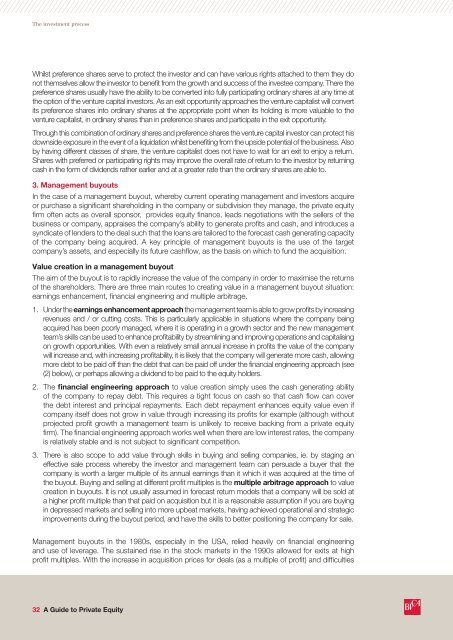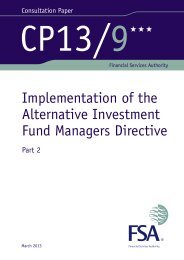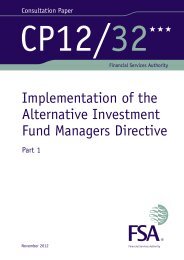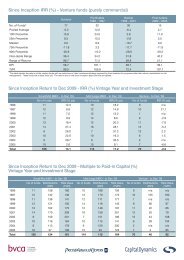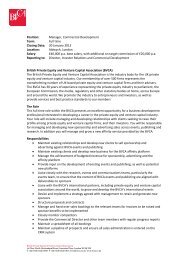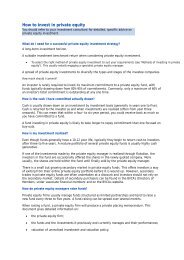A Guide to Private Equity - BVCA admin
A Guide to Private Equity - BVCA admin
A Guide to Private Equity - BVCA admin
Create successful ePaper yourself
Turn your PDF publications into a flip-book with our unique Google optimized e-Paper software.
The investment process<br />
Whilst preference shares serve <strong>to</strong> protect the inves<strong>to</strong>r and can have various rights attached <strong>to</strong> them they do<br />
not themselves allow the inves<strong>to</strong>r <strong>to</strong> benefit from the growth and success of the investee company. There the<br />
preference shares usually have the ability <strong>to</strong> be converted in<strong>to</strong> fully participating ordinary shares at any time at<br />
the option of the venture capital inves<strong>to</strong>rs. As an exit opportunity approaches the venture capitalist will convert<br />
its preference shares in<strong>to</strong> ordinary shares at the appropriate point when its holding is more valuable <strong>to</strong> the<br />
venture capitalist, in ordinary shares than in preference shares and participate in the exit opportunity.<br />
Through this combination of ordinary shares and preference shares the venture capital inves<strong>to</strong>r can protect his<br />
downside exposure in the event of a liquidation whilst benefiting from the upside potential of the business. Also<br />
by having different classes of share, the venture capitalist does not have <strong>to</strong> wait for an exit <strong>to</strong> enjoy a return.<br />
Shares with preferred or participating rights may improve the overall rate of return <strong>to</strong> the inves<strong>to</strong>r by returning<br />
cash in the form of dividends rather earlier and at a greater rate than the ordinary shares are able <strong>to</strong>.<br />
3. Management buyouts<br />
In the case of a management buyout, whereby current operating management and inves<strong>to</strong>rs acquire<br />
or purchase a significant shareholding in the company or subdivision they manage, the private equity<br />
firm often acts as overall sponsor, provides equity finance, leads negotiations with the sellers of the<br />
business or company, appraises the company’s ability <strong>to</strong> generate profits and cash, and introduces a<br />
syndicate of lenders <strong>to</strong> the deal such that the loans are tailored <strong>to</strong> the forecast cash generating capacity<br />
of the company being acquired. A key principle of management buyouts is the use of the target<br />
company’s assets, and especially its future cashflow, as the basis on which <strong>to</strong> fund the acquisition.<br />
Value creation in a management buyout<br />
The aim of the buyout is <strong>to</strong> rapidly increase the value of the company in order <strong>to</strong> maximise the returns<br />
of the shareholders. There are three main routes <strong>to</strong> creating value in a management buyout situation:<br />
earnings enhancement, financial engineering and multiple arbitrage.<br />
1. Under the earnings enhancement approach the management team is able <strong>to</strong> grow profits by increasing<br />
revenues and / or cutting costs. This is particularly applicable in situations where the company being<br />
acquired has been poorly managed, where it is operating in a growth sec<strong>to</strong>r and the new management<br />
team’s skills can be used <strong>to</strong> enhance profitability by streamlining and improving operations and capitalising<br />
on growth opportunities. With even a relatively small annual increase in profits the value of the company<br />
will increase and, with increasing profitability, it is likely that the company will generate more cash, allowing<br />
more debt <strong>to</strong> be paid off than the debt that can be paid off under the financial engineering approach (see<br />
(2) below), or perhaps allowing a dividend <strong>to</strong> be paid <strong>to</strong> the equity holders.<br />
2. The financial engineering approach <strong>to</strong> value creation simply uses the cash generating ability<br />
of the company <strong>to</strong> repay debt. This requires a tight focus on cash so that cash flow can cover<br />
the debt interest and principal repayments. Each debt repayment enhances equity value even if<br />
company itself does not grow in value through increasing its profits for example (although without<br />
projected profit growth a management team is unlikely <strong>to</strong> receive backing from a private equity<br />
firm). The financial engineering approach works well when there are low interest rates, the company<br />
is relatively stable and is not subject <strong>to</strong> significant competition.<br />
3. There is also scope <strong>to</strong> add value through skills in buying and selling companies, ie. by staging an<br />
effective sale process whereby the inves<strong>to</strong>r and management team can persuade a buyer that the<br />
company is worth a larger multiple of its annual earnings than it which it was acquired at the time of<br />
the buyout. Buying and selling at different profit multiples is the multiple arbitrage approach <strong>to</strong> value<br />
creation in buyouts. It is not usually assumed in forecast return models that a company will be sold at<br />
a higher profit multiple than that paid on acquisition but it is a reasonable assumption if you are buying<br />
in depressed markets and selling in<strong>to</strong> more upbeat markets, having achieved operational and strategic<br />
improvements during the buyout period, and have the skills <strong>to</strong> better positioning the company for sale.<br />
Management buyouts in the 1980s, especially in the USA, relied heavily on financial engineering<br />
and use of leverage. The sustained rise in the s<strong>to</strong>ck markets in the 1990s allowed for exits at high<br />
profit multiples. With the increase in acquisition prices for deals (as a multiple of profit) and difficulties<br />
32 A <strong>Guide</strong> <strong>to</strong> <strong>Private</strong> <strong>Equity</strong>


